Eco-Sustainable Energy Production in Healthcare: Trends and Challenges in Renewable Energy Systems
Abstract
:1. Introduction
Problem Statement
2. Literature Review
2.1. Techno-Economic Evaluations
2.2. Emission Reduction and Environmental Impacts
2.3. Optimization and Efficiency
2.4. Resilience, Storage, and Microgrids
2.5. Regional and Case Studies
2.6. Miscellaneous Innovations
3. Literature Analysis
- Geographical distribution of articles;
- System configurations and auxiliary components;
- System installation modes;
- Analysis typology.
3.1. Geographical Distribution of Articles
3.2. System Configurations and Auxiliary Components
- Energy Generation Auxiliary Systems: These components generate electrical energy in case of renewable sources or other generation system failures, forming single or multiple cogeneration systems (electricity, heat, air conditioning, hot water, hydrogen, etc.).
- Energy Storage Systems: These systems store excess energy from renewable sources using electrical, thermal, hydrogen, or other storage methods.
- The most used system for energy production is the PV system, with a utilization rate of 25%.
- Wind-based energy production systems come in second place with a utilization rate of 15%.
- Geothermal energy generation systems rank third with a utilization rate of 12%.
- Batteries are the most employed energy storage system, as 18 out of 29 articles describe systems incorporating a battery. In 14 of these articles, the battery is combined with another auxiliary component, and in eight of these cases, it is paired with a different storage system.
- Seven articles describe the operation of hybrid systems by analyzing multiple auxiliary components.
- The diesel generator is one of the most-used auxiliary generation systems, with a utilization rate of 20%.
- Biomass-based systems are the second most-used auxiliary generation systems. They are primarily employed in remote locations where renewable energy production is unfeasible due to unfavorable conditions, such as arctic and polar climates.
- Fuel cells, either standalone or in combination, are the second most-used auxiliary generation system, with three articles, two of which are in combination with a battery. Biomass ranks third.
- In 22 case studies, the contribution of installing a PV system to produce energy from renewable sources is analyzed.
- In 6 case studies, energy production comes from systems other than PV, such as wind systems, biomass, single or multiple CHP cogeneration plants, diesel generators, and geothermal and heat pump hybrid systems.
- In 1 case study out of the twenty-nine analyzed, it was not possible to obtain information on the use of PV as an energy production plant since it was not specified.
- Economic analysis: the break-even point (BEP) is determined, factoring in the primary installation costs and projecting the time required for cost recovery. This analysis also highlights the savings accrued from autonomous renewable energy production over direct electricity purchases from the national grid.
- Energetic analysis: the potential energy production and storage throughout the system’s life cycle, either through hands-on experiments or simulations.
- Optimization analysis: the system’s energy output for enhanced economic and environmental returns. It emphasizes the strategic use of renewable energy during peak pricing periods and the leveraging of the national grid during off-peak hours for cost efficiency.
3.3. System Installation Mode
- Nine articles focus on stand-alone systems.
- A number of 13 articles focus on grid-connected systems.
- Only one article concerns both stand-alone and grid-connected systems to make a comparison or provide the system with various auxiliary components.
- An amount of seven articles do not indicate the system mode.
- Public/Private Hospitals: These are large establishments that require significant energy loads due to their operations, patient intake, and equipment usage.
- Private Clinics: Typically smaller than hospitals, these facilities still have energy needs, especially if they house specialized equipment.
- Medical-University Campuses: These are expansive establishments, often encompassing a mix of educational facilities and healthcare services, leading to varied energy requirements.
3.4. Analysis Typology
- An amount of 15 articles (52%) conducted studies based solely on simulations.
- An amount of 14 articles (48%) presented exclusively experimental studies.
- Parametric analysis, aimed at optimizing parameters through algorithms for system sizing;
- Non-parametric analysis, focusing on the examination of a specific system’s performance in terms of economic, energetic, or environmental aspects.
- 25 articles (86.2%) proposed a parametric analysis;
- four articles (13.8%) developed a non-parametric analysis;
- 22 articles indicated the software used to conduct the study;
- And two of these articles utilized more than one software.
3.5. Combined Data Analysis
4. Conclusions
- Iran and China have the highest number of publications in Asia, while Italy and Spain are notable in Europe.
- The experimental analysis is the predominant study methodology.
- Batteries are the most frequently used auxiliary components for both stand-alone and grid-connected systems. Diesel generators are mainly employed in stand-alone systems, while grid-connected systems use biomass, fuel cells, and geothermal probes.
- Grid-connected systems are more extensively studied due to their applicability in medium and large-sized healthcare facilities, especially in densely populated urban areas. Stand-alone systems are prevalent in remote climatic zones and developing countries where a continuous energy supply from the national grid is unreliable.
- Some systems combine grid connections with autonomous operations to reduce overall costs and ensure efficient operation and service delivery.
- Hospital-use is the primary context, focusing on public structures. The parametric analysis is the most developed methodology, emphasizing the optimal sizing of systems based on energy, economic, and environmental criteria.
- Photovoltaic systems are preferred for low and medium power, while wind systems are more important for larger systems, often in combination with other auxiliary components and hybrid or cogeneration systems. Photovoltaic systems are used to cover load variations/interruptions where needed.
Author Contributions
Funding
Data Availability Statement
Conflicts of Interest
References
- Mazzeo, D.; Matera, N.; De Luca, P.; Baglivo, C.; Congedo, P.M.; Oliveti, G. A literature review and statistical analysis of photovoltaic-wind hybrid renewable system research by considering the most relevant 550 articles: An upgradable matrix literature database. J. Clean. Prod. 2021, 295, 126070. [Google Scholar] [CrossRef]
- Abe, J.O.; Popoola, A.P.I.; Ajenifuja, E.; Popoola, O.M. Hydrogen energy, economy and storage: Review and recommendation. Int. J. Hydrogen Energy 2019, 44, 15072–15086. [Google Scholar] [CrossRef]
- El Hannach, M.; Ahmadi, P.; Guzman, L.; Pickup, S.; Kjeang, E. Life cycle assessment of hydrogen and diesel dual-fuel class 8 heavy duty trucks. Int. J. Hydrogen Energy 2019, 44, 8575–8584. [Google Scholar] [CrossRef]
- Izadi, A.; Shahafve, M.; Ahmadi, P.; Javani, N. Transient simulation and techno-economic assessment of a near-zero energy building using a hydrogen storage system and different backup fuels. Int. J. Hydrogen Energy 2022, 47, 31927–31940. [Google Scholar] [CrossRef]
- Nastasi, B.; Mazzoni, S.; Groppi, D.; Romagnoli, A.; Astiaso Garcia, D. Optimized integration of Hydrogen technologies in Island energy systems. Renew. Energy 2021, 174, 850–864. [Google Scholar] [CrossRef]
- Nastasi, B.; Mazzoni, S.; Groppi, D.; Romagnoli, A.; Astiaso Garcia, D. Solar power-to-gas application to an island energy system. Renew. Energy 2021, 164, 1005–1016. [Google Scholar] [CrossRef]
- Ammari, C.; Belatrache, D.; Touhami, B.; Makhloufi, S. Sizing, optimization, control and energy management of hybrid renewable energy system—A review. Energy Built Environ. 2022, 3, 399–411. [Google Scholar] [CrossRef]
- Mazzeo, D.; Oliveti, G.; Baglivo, C.; Congedo, P.M. Energy reliability-constrained method for the multi-objective optimization of a photovoltaic-wind hybrid system with battery storage. Energy 2018, 156, 688–708. [Google Scholar] [CrossRef]
- Mazzeo, D.; Matera, N.; De Luca, P.; Baglivo, C.; Maria Congedo, P.; Oliveti, G. Worldwide geographical mapping and optimization of stand-alone and grid-connected hybrid renewable system techno-economic performance across Köppen-Geiger climates. Appl. Energy 2020, 276, 115507. [Google Scholar] [CrossRef]
- Izadi, A.; Shahafve, M.; Ahmadi, P.; Hanafizadeh, P. Design, and optimization of COVID-19 hospital wards to produce Oxygen and electricity through solar PV panels with hydrogen storage systems by neural network-genetic algorithm. Energy 2023, 263, 125578. [Google Scholar] [CrossRef]
- Babatunde, O.M.; Munda, J.L.; Hamam, Y. Hybridized off-grid fuel cell/wind/solar PV /battery for energy generation in a small household: A multi-criteria perspective. Int. J. Hydrogen Energy 2022, 47, 6437–6452. [Google Scholar] [CrossRef]
- Rahmouni, S.; Negrou, B.; Settou, N.; Dominguez, J.; Gouareh, A. Prospects of hydrogen production potential from renewable resources in Algeria. Int. J. Hydrogen Energy 2017, 42, 1383–1395. [Google Scholar] [CrossRef]
- Zaik, K.; Werle, S. Solar and wind energy in Poland as power sources for electrolysis process—A review of studies and experimental methodology. Int. J. Hydrogen Energy 2023, 48, 11628–11639. [Google Scholar] [CrossRef]
- Ajanovic, A.; Sayer, M.; Haas, R. The economics and the environmental benignity of different colors of hydrogen. Int. J. Hydrogen Energy 2022, 47, 24136–24154. [Google Scholar] [CrossRef]
- Maggio, G.; Nicita, A.; Squadrito, G. How the hydrogen production from RES could change energy and fuel markets: A review of recent literature. Int. J. Hydrogen Energy 2019, 44, 11371–11384. [Google Scholar] [CrossRef]
- Haryanto, A.; Fernando, S.; Murali, N.; Adhikari, S. Current Status of Hydrogen Production Techniques by Steam Reforming of Ethanol: A Review. Energy Fuels 2005, 19, 2098–2106. [Google Scholar] [CrossRef]
- Salam, M.A.; Ahmed, K.; Akter, N.; Hossain, T.; Abdullah, B. A review of hydrogen production via biomass gasification and its prospect in Bangladesh. Int. J. Hydrogen Energy 2018, 43, 14944–14973. [Google Scholar] [CrossRef]
- Lee, J.E.; Shafiq, I.; Hussain, M.; Lam, S.S.; Rhee, G.H.; Park, Y.K. A review on integrated thermochemical hydrogen production from water. Int. J. Hydrogen Energy 2022, 47, 4346–4356. [Google Scholar] [CrossRef]
- Ni, M.; Leung, M.K.H.; Leung, D.Y.C.; Sumathy, K. A review and recent developments in photocatalytic water-splitting using TiO2 for hydrogen production. Renew. Sustain. Energy Rev. 2007, 11, 401–425. [Google Scholar] [CrossRef]
- Dawood, F.; Anda, M.; Shafiullah, G.M. Hydrogen production for energy: An overview. Int. J. Hydrogen Energy 2020, 45, 3847–3869. [Google Scholar] [CrossRef]
- Bartels, J.R.; Pate, M.B.; Olson, N.K. An economic survey of hydrogen production from conventional and alternative energy sources. Int. J. Hydrogen Energy 2010, 35, 8371–8384. [Google Scholar] [CrossRef]
- Banerjee, S.; Musa, M.N.; Jaafar, A.B. Economic assessment and prospect of hydrogen generated by OTEC as future fuel. Int. J. Hydrogen Energy 2017, 42, 26–37. [Google Scholar] [CrossRef]
- Ourya, I.; Nabil, N.; Abderafi, S.; Boutammachte, N.; Rachidi, S. Assessment of green hydrogen production in Morocco, using hybrid renewable sources (PV and wind). Int. J. Hydrogen Energy 2023, in press. [Google Scholar] [CrossRef]
- Kojima, H.; Nagasawa, K.; Todoroki, N.; Ito, Y.; Matsui, T.; Nakajima, R. Influence of renewable energy power fluctuations on water electrolysis for green hydrogen production. Int. J. Hydrogen Energy 2023, 48, 4572–4593. [Google Scholar] [CrossRef]
- Touili, S.; Alami Merrouni, A.; El Hassouani, Y.; Amrani, A.I.; Rachidi, S. Analysis of the yield and production cost of large-scale electrolytic hydrogen from different solar technologies and under several Moroccan climate zones. Int. J. Hydrogen Energy 2020, 45, 26785–26799. [Google Scholar] [CrossRef]
- Isa, N.M.; Das, H.S.; Tan, C.W.; Yatim, A.H.M.; Lau, K.Y. A techno-economic assessment of a combined heat and power photovoltaic/fuel cell/battery energy system in Malaysia hospital. Energy 2016, 112, 75–90. [Google Scholar] [CrossRef]
- Bornand, B.; Girardin, L.; Belfiore, F.; Robineau, J.L.; Bottallo, S.; Maréchal, F. Investment Planning Methodology for Complex Urban Energy Systems Applied to a Hospital Site. Front. Energy Res. 2020, 8, 264. [Google Scholar] [CrossRef]
- Buonomano, A.; Calise, F.; Ferruzzi, G.; Vanoli, L. A novel renewable polygeneration system for hospital buildings: Design, simulation and thermo-economic optimization. Appl. Therm. Eng. 2014, 67, 43–60. [Google Scholar] [CrossRef]
- Prada, M.; Prada, I.F.; Cristea, M.; Popescu, D.E.; Bungău, C.C.; Aleya, L.; Bungău, C.C. New solutions to reduce greenhouse gas emissions through energy efficiency of buildings of special importance—Hospitals. Sci. Total Environ. 2020, 718, 137446. [Google Scholar] [CrossRef]
- Alotaibi, D.M.; Akrami, M.; Dibaj, M.; Javadi, A.A. Smart energy solution for an optimised sustainable hospital in the green city of NEOM. Sustain. Energy Technol. Assess. 2019, 35, 32–40. [Google Scholar] [CrossRef]
- Chen, X.; Chen, Y.; Zhang, M.; Jiang, S.; Gou, H.; Pang, Z.; Shen, B. Hospital-oriented quad-generation (HOQG)—A combined cooling, heating, power and gas (CCHPG) system. Appl. Energy 2021, 300, 117382. [Google Scholar] [CrossRef]
- Zaza, P.N.; Sepetis, A.; Bagos, P.G. Prediction and Optimization of the Cost of Energy Resources in Greek Public Hospitals. Energies 2022, 15, 381. [Google Scholar] [CrossRef]
- Ma, D.; Zhang, L.; Sun, B. An interval scheduling method for the CCHP system containing renewable energy sources based on model predictive control. Energy 2021, 236, 121418. [Google Scholar] [CrossRef]
- Ascione, F.; Bianco, N.; De Stasio, C.; Mauro, G.M.; Vanoli, G.P. Multi-stage and multi-objective optimization for energy retrofitting a developed hospital reference building: A new approach to assess cost-optimality. Appl. Energy 2016, 174, 37–68. [Google Scholar] [CrossRef]
- Sigarchian, S.G.; Malmquist, A.; Martin, V. Design Optimization of a Complex Polygeneration System for a Hospital. Energies 2018, 11, 1071. [Google Scholar] [CrossRef]
- Jahangir, M.H.; Eslamnezhad, S.; Mousavi, S.A.; Askari, M. Multi-year sensitivity evaluation to supply prime and deferrable loads for hospital application using hybrid renewable energy systems. J. Build. Eng. 2021, 40, 102733. [Google Scholar] [CrossRef]
- Luo, S.; Li, H.; Mao, Y.; Yang, C. Experimental research on a novel sun shading & solar energy collecting coupling device for inpatient building in hot summer and cold winter climate zone in China. Appl. Therm. Eng. 2018, 142, 89–99. [Google Scholar] [CrossRef]
- Dursun, S.; Aykut, E.; Dursun, B. Assessment of Optimum Renewable Energy System for the Somalia–Turkish Training and Research Hospital in Mogadishu. J. Renew. Energy Environ. 2021, 8, 54–67. [Google Scholar] [CrossRef]
- Lagrange, A.; de Simón-Martín, M.; González-Martínez, A.; Bracco, S.; Rosales-Asensio, E. Sustainable microgrids with energy storage as a means to increase power resilience in critical facilities: An application to a hospital. Int. J. Electr. Power Energy Syst. 2020, 119, 105865. [Google Scholar] [CrossRef]
- Vaziri, S.M.; Rezaee, B.; Monirian, M.A. Utilizing renewable energy sources efficiently in hospitals using demand dispatch. Renew. Energy 2020, 151, 551–562. [Google Scholar] [CrossRef]
- Mustafa, M.B.; Keatley, P.; Huang, Y.; Agbonaye, O.; Ademulegun, O.O.; Hewitt, N. Evaluation of a battery energy storage system in hospitals for arbitrage and ancillary services. J. Energy Storage 2021, 43, 103183. [Google Scholar] [CrossRef]
- Borges de Oliveira, K.; dos Santos, E.F.; Neto, A.F.; de Mello Santos, V.H.; de Oliveira, O.J. Guidelines for efficient and sustainable energy management in hospital buildings. J. Clean. Prod. 2021, 329, 129644. [Google Scholar] [CrossRef]
- Burch, H.; Anstey, M.H.; McGain, F. Renewable energy use in Australian public hospitals. Med. J. Aust. 2021, 215, 160–163.e1. [Google Scholar] [CrossRef] [PubMed]
- Kahwash, F.; Barakat, B.; Taha, A.; Abbasi, Q.H.; Imran, M.A. Optimising Electrical Power Supply Sustainability Using a Grid-Connected Hybrid Renewable Energy System—An NHS Hospital Case Study. Energies 2021, 14, 7084. [Google Scholar] [CrossRef]
- Alamoudi, R.; Taylan, O.; Aktacir, M.A.; Herrera-viedma, E. Designing a Solar Photovoltaic System for Generating Renewable Energy of a Hospital: Performance Analysis and Adjustment Based on RSM and ANFIS Approaches. Mathematics 2021, 9, 2929. [Google Scholar] [CrossRef]
- Ogunmodede, O.; Anderson, K.; Cutler, D.; Newman, A. Optimizing design and dispatch of a renewable energy system. Appl. Energy 2021, 287, 116527. [Google Scholar] [CrossRef]
- Bardineh, Y.H.; Mohamadian, F.; Ahmadi, M.H.; Akbarianrad, N. Medical and dental applications of renewable energy systems. Int. J. Low-Carbon Technol. 2018, 13, 320–326. [Google Scholar] [CrossRef]
- Sánchez-Barroso, G.; González-Domínguez, J.; GarcíA-Sanz-Calcedo, J. Potential Savings in DHW Facilities through the Use of Solar Thermal Energy in the Hospitals of Extremadura (Spain). Int. J. Environ. Res. Public Health 2020, 17, 2658. [Google Scholar] [CrossRef]
- García-Sanz-calcedo, J.; López-Rodriguez, F.; Yusaf, T.; Al-Kassir, A. Analysis of the Average Annual Consumption of Water in the Hospitals of Extremadura (Spain). Energies 2017, 10, 479. [Google Scholar] [CrossRef]
- Bujak, J. Heat consumption for preparing domestic hot water in hospitals. Energy Build. 2010, 42, 1047–1055. [Google Scholar] [CrossRef]
- Amran, M.E.; Muhtazaruddin, M.N.; Muhammad-Sukki, F.; Bani, N.A.; Zaidi, T.Z.A.; Kamaluddin, K.A.; Ardila-Rey, J.A. Photovoltaic Expansion-Limit through a Net Energy Metering Scheme for Selected Malaysian Public Hospitals. Sustainability 2019, 11, 5131. [Google Scholar] [CrossRef]
- Carnero, M.C.; Gómez, A. A Multicriteria Model for Optimization of Maintenance in Thermal Energy Production Systems in Hospitals: A Case Study in a Spanish Hospital. Sustainability 2017, 9, 493. [Google Scholar] [CrossRef]
- Maggio, G.; Squadrito, G.; Nicita, A. Hydrogen and medical oxygen by renewable energy based electrolysis: A green and economically viable route. Appl. Energy 2022, 306, 117993. [Google Scholar] [CrossRef]
- Kantola, M.; Saari, A. Renewable vs. traditional energy management solutions—A Finnish hospital facility case. Renew. Energy 2013, 57, 539–545. [Google Scholar] [CrossRef]

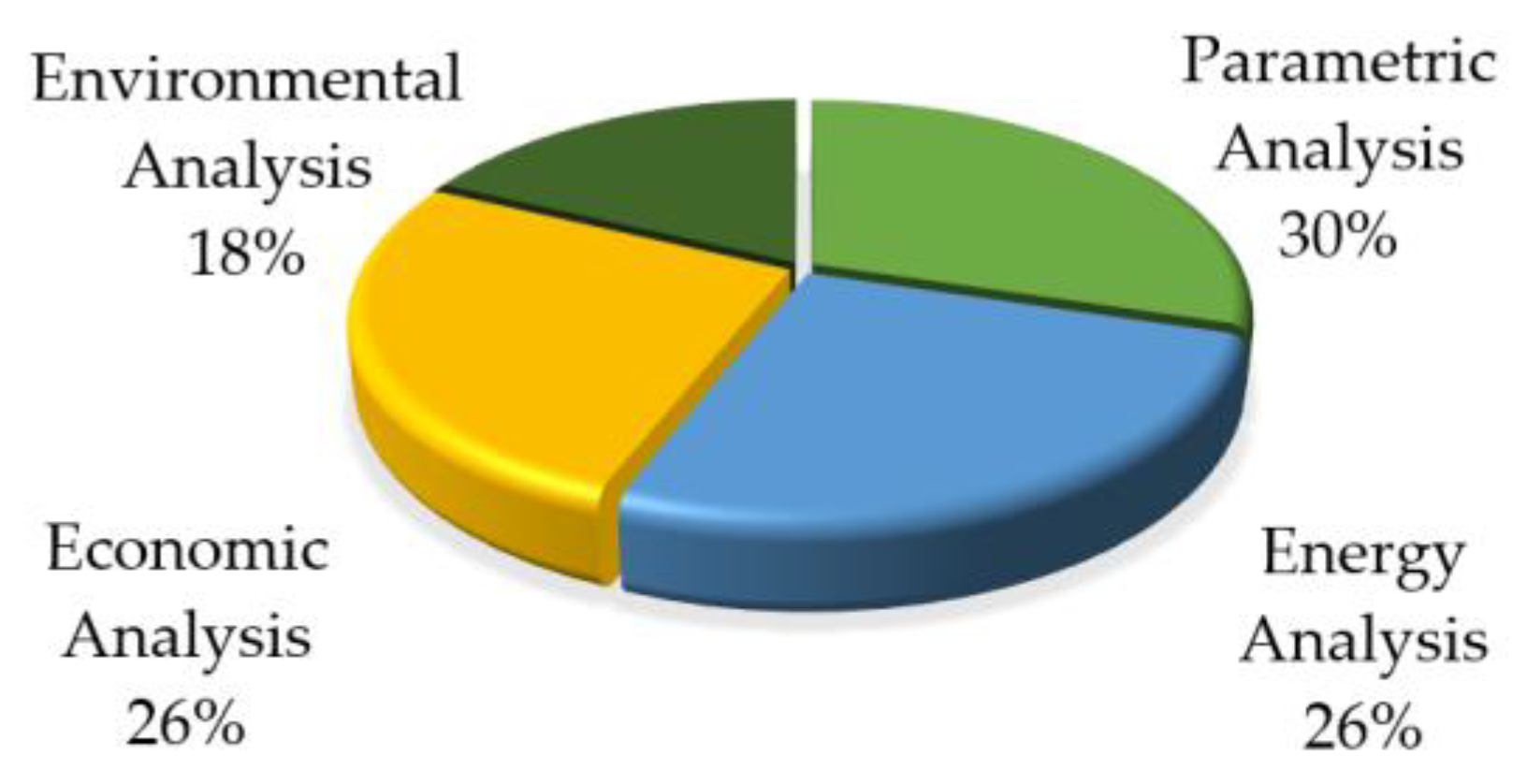
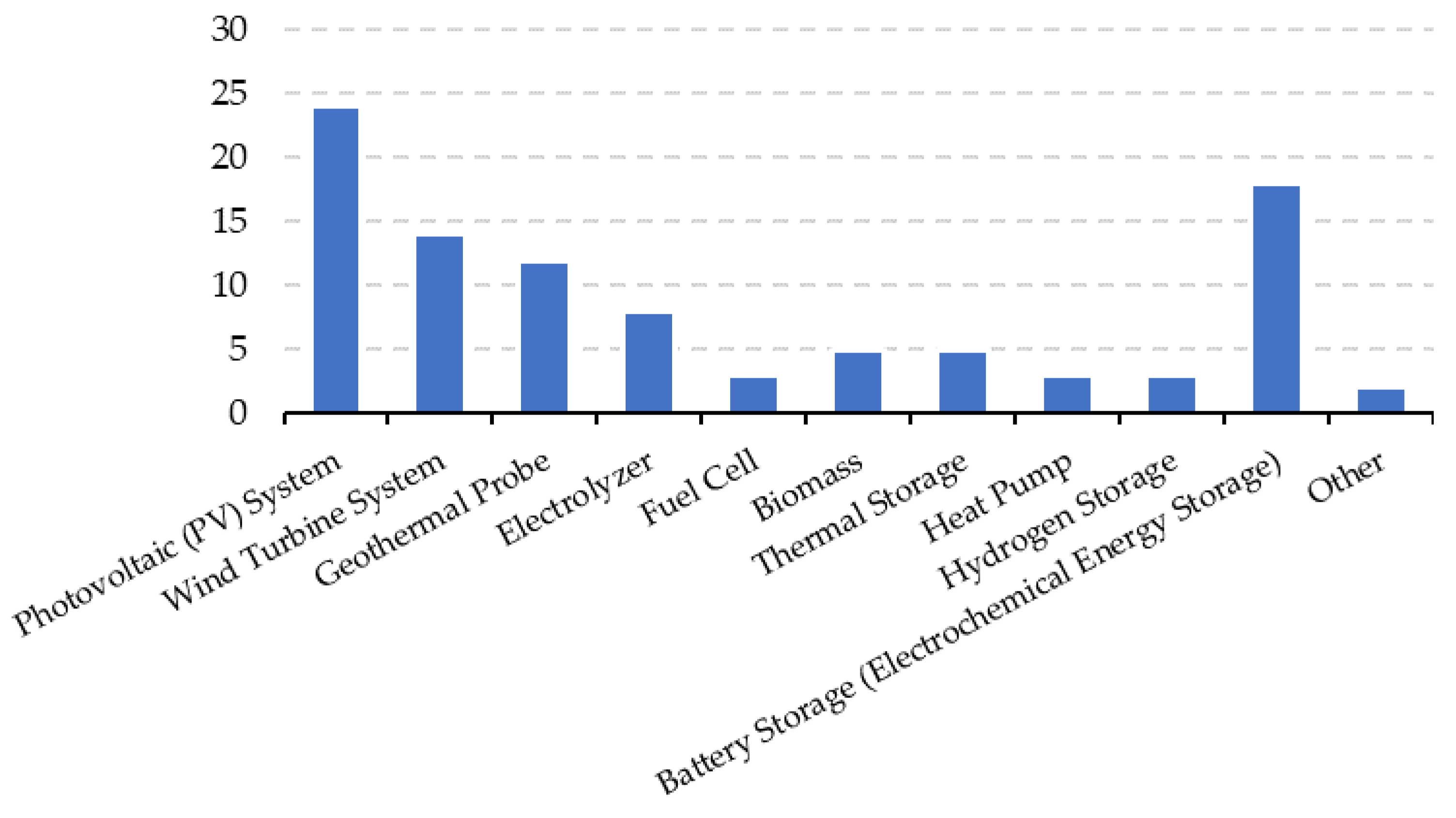
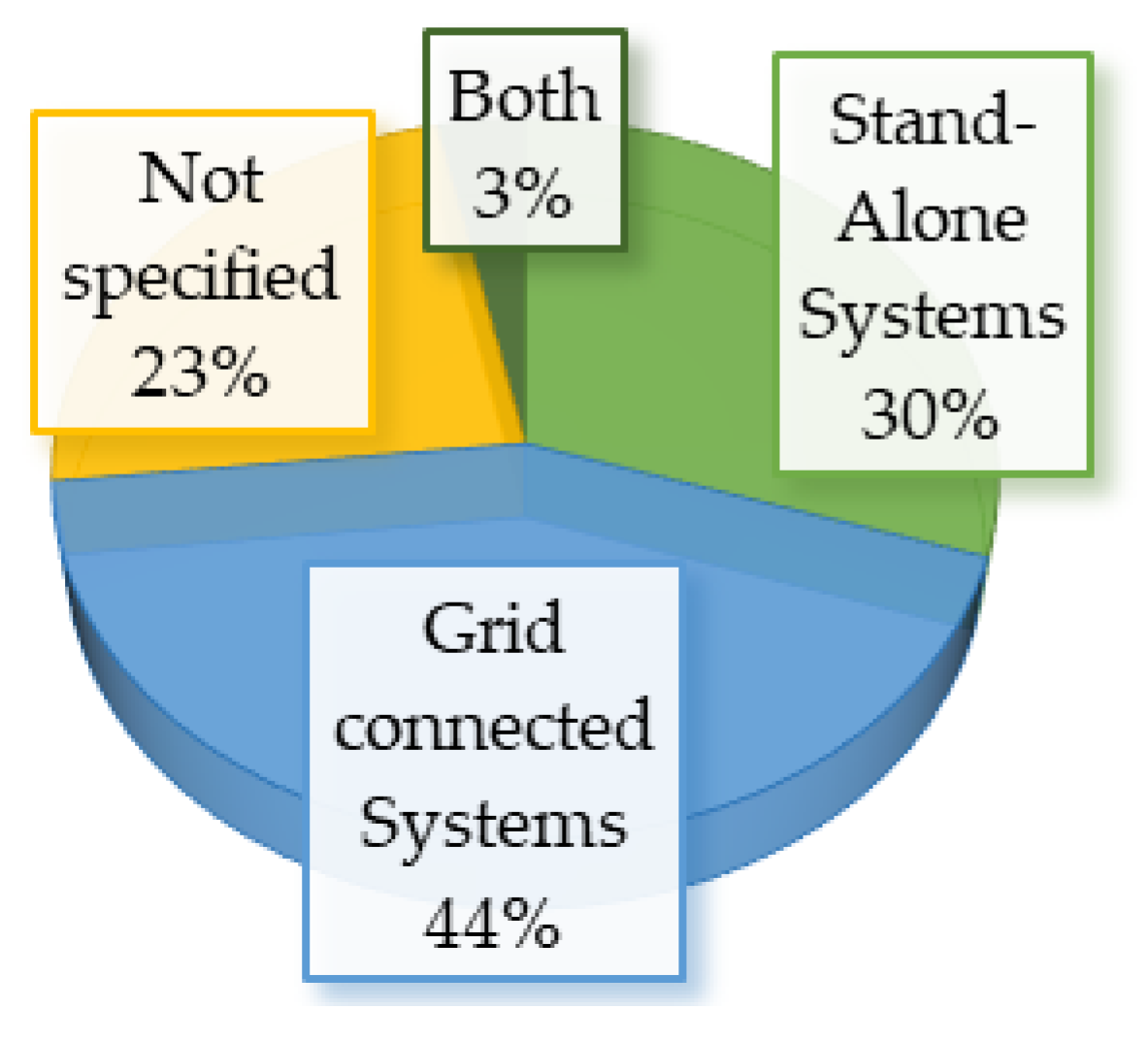

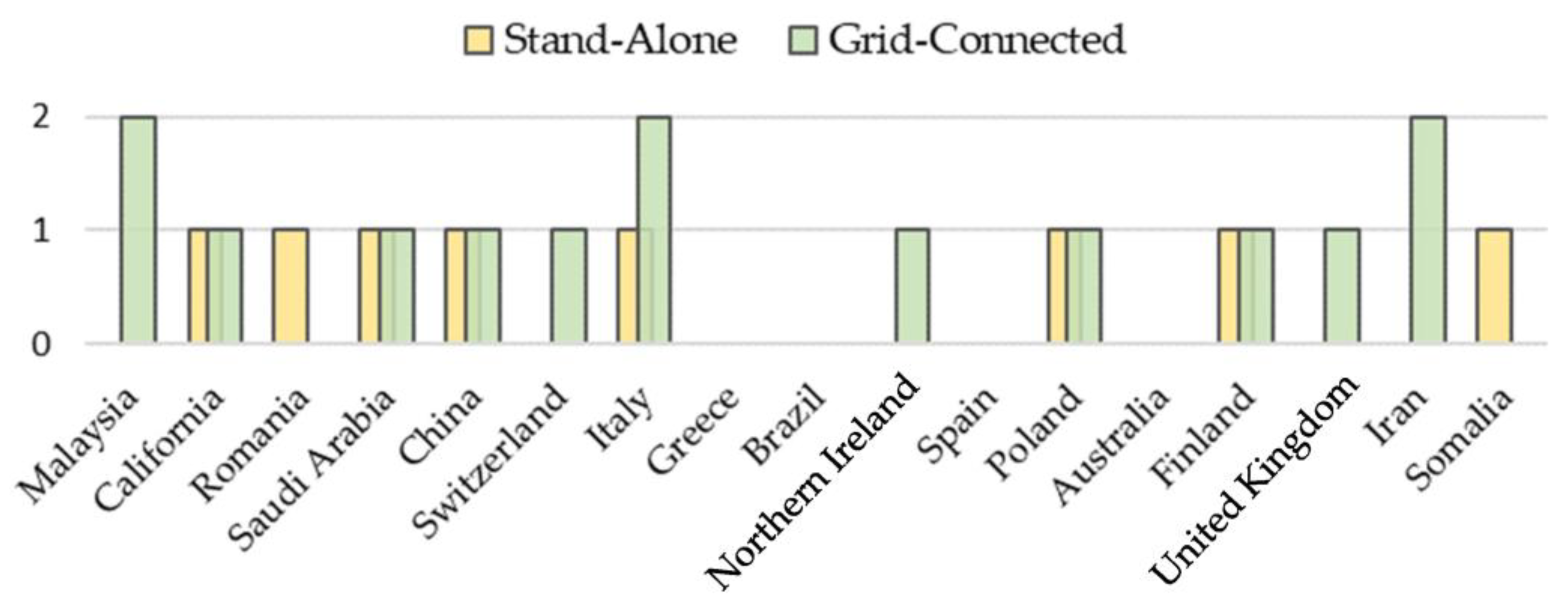
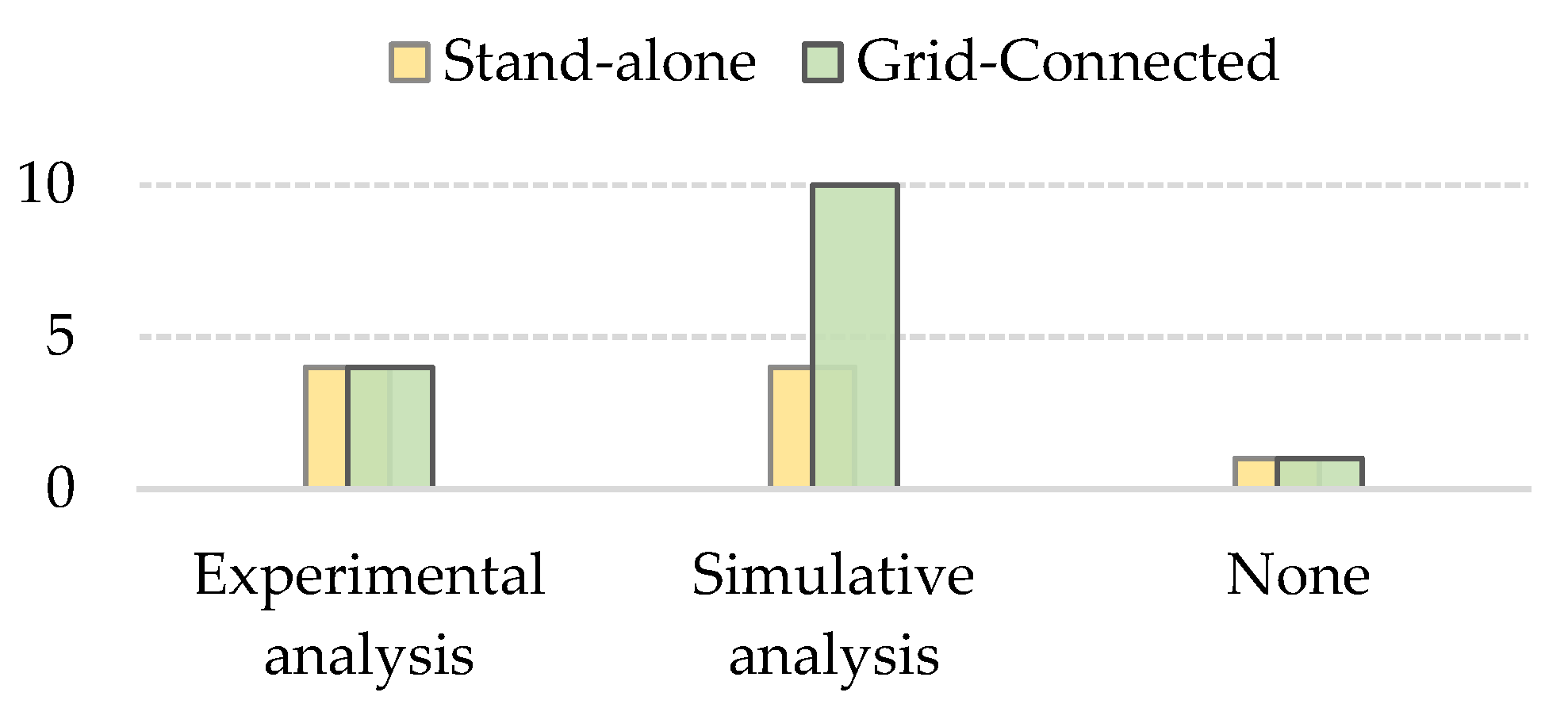
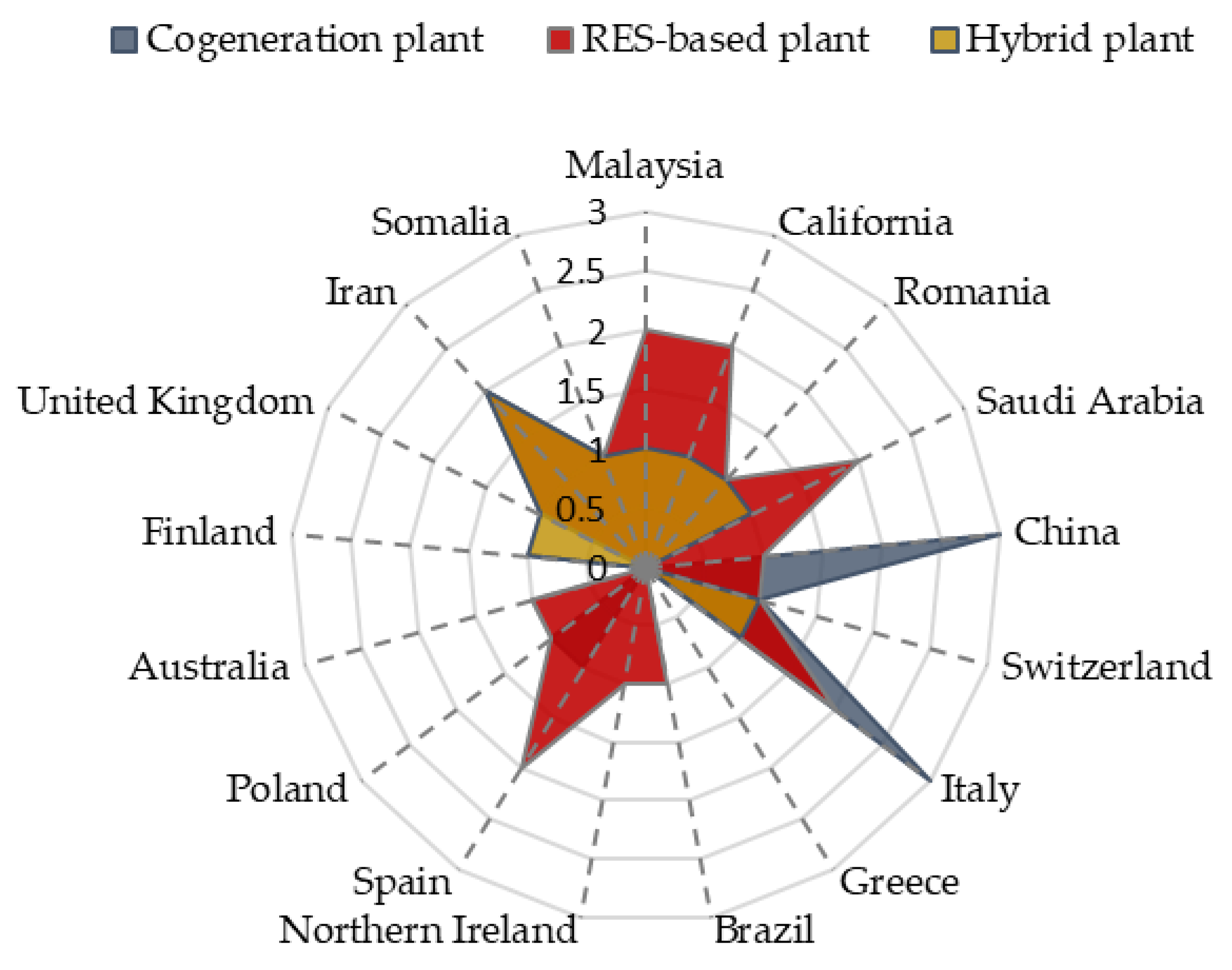
| Article | Country | Location | Facility Specifications (Size, Volume, Floor Surface, Beds) | Type and Category of the Facility |
|---|---|---|---|---|
| [26] | Malaysia | Cheras, Selangor | Number of beds: 873 | University Hospital |
| [27] | Switzerland | Geneva | Area: 332,311 m2, Number of beds: 1224 | Private Hospital |
| [28] | Italy | Naples | Area: 270,000 m2, Volume: 1,130,000 m3, Number of beds: 2800 | University Hospital |
| [29] | Romania | Oradea | Not Specified | Public Hospital |
| [30] | Saudi Arabia | Neom | Not Specified | Hospital |
| [31] | China | Not Specified | Not Specified | Hospital |
| [32] | Greece | Data from all public hospitals in Greece | Not Specified | 121 Public Hospital |
| [33] | China | Jinan | Total area: 33,000 m2, Average floor height: 3.5 m, Number of floors: 19 | Hospital |
| [34] | Italy | Naples | Volume: 90,828 m3, Area: 22,711 m2 | Public Hospital |
| [35] | Italy | North Italy | Not Specified | Hospital |
| [36] | Iran | Tehran | Not Specified | Hospital |
| [37] | China | Changsha | Not Specified | Hospital |
| [38] | Somalia | Mogadishu | Not Specified | Hospital |
| [39] | USA (California) | Palmdale | Area: 30,000 m2, Number of beds: 171 | Private Hospital |
| [40] | Iran | Not Specified | Number of beds: 900 | Hospital |
| [41] | UK (Northern Ireland) | Belfast City | Number of beds: 2058 | 6 Public/Private Hospitals/Clinics |
| [42] | Australia | Not Specified | Not Specified | Hospital |
| [43] | UK | South-east England | Not Specified | Hospital |
| [44] | Saudi Arabia | Jeddah | Number of beds: 715 | University Hospital |
| [45] | USA | San Diego—Cheyenne | Not Specified | Case 1: Hospital—Case 2: Campus |
| [46] | Poland | Bydgoszcz | Not Specified | Hospital |
| [47] | Spain | Region of Extremadura—Cities of Badajoz/Cáceres | Total area: from 533 to 87,118 m2, Number of beds: from 15 to 529 | 25 Private/Public Hospital in the region of Extremadura, Spain |
| [48] | Spain | Region of Extremadura | Total area: from 13,300 m2 to 66,326 m2, Number of beds: from 43 to 508 | 13 Private/Public Hospital in the region of Extremadura, Spain |
| [49] | Poland | Hospital A: Bydgoszcz—Hospital B: Province | Hospital A: Number of beds: 715, Volume: 160,849 m3, Usable area: 27,586 m2, Hospital B: Number of Beds: 810 | A: University Hospital /B: Provincial Hospital |
| [50] | Malaysia | Not Specified | Not Specified | Public Hospital |
| [51] | Spain | Ciudad Real | Not Specified | Hospital |
| [52] | Not Specified | Not Specified | Number of beds: up to 500 | Hospital |
| [53] | Finland | Espoo | Not Specified | Hospital |
| [54] | Country | Location | Facility Specifications (Size, Volume, Floor Surface, Beds) | Type and Category of the Facility |
| Article | Country | PV | WIND | Geothermal | Flat Solar Collector | Concentrating Solar Collector | Electrolysis System | Fuel Cell | Biomass |
|---|---|---|---|---|---|---|---|---|---|
| [26] | Malaysia | Yes | No | No | Yes | - | Yes | Yes | No |
| [39] | California | Yes | No | No | Yes | - | No | No | No |
| [29] | Romania | Yes | No | Yes | - | - | No | No | No |
| [30] | Saudi Arabia | Yes | No | No | - | - | No | No | Yes |
| [33] | China | Yes | Yes | No | Yes | - | No | No | No |
| [27] | Swiss | Yes | No | No | - | - | Yes | Yes | No |
| [34] | Italy | Yes | No | Yes | Yes | - | No | No | No |
| [32] | Greek | No | No | No | - | - | No | No | No |
| [42] | Brazil | Yes | No | No | - | - | - | - | - |
| [41] | North Ireland | Yes | Yes | No | - | - | No | Yes | No |
| [28] | Italy | Yes | No | No | No | Yes | No | No | No |
| [52] | Spain | No | No | No | No | No | No | No | No |
| [37] | China | No | No | No | No | No | No | No | No |
| [48] | Spain | Yes | No | No | Yes | No | No | No | No |
| [49] | Spain | Yes | No | No | Yes | No | No | No | No |
| [53] | - | Yes | No | No | Yes | No | Yes | No | No |
| [46] | California—Wyoming | Yes | Yes | No | - | - | No | No | No |
| [47] | Poland | Yes | No | No | Yes | No | No | No | No |
| [45] | Saudi Arabia | Yes | No | No | - | - | No | No | No |
| [43] | Australia | - | - | - | - | - | - | - | - |
| [54] | Finland | Yes | No | Yes | - | - | No | No | Yes |
| [44] | UK | Yes | No | No | - | - | No | No | No |
| [36] | Iran | Yes | Yes | No | - | - | No | No | No |
| [40] | Iran | Yes | Yes | No | - | - | No | No | No |
| [31] | China | Yes | Yes | No | Yes | No | Yes | No | No |
| [35] | Italy | Yes | Yes | No | - | - | No | No | No |
| [50] | Poland | No | No | No | No | No | No | No | No |
| [51] | Malaysia | Yes | No | No | No | No | No | No | No |
| [38] | Somalia | Yes | Yes | No | Yes | No | No | No | No |
| Article | Country | Description | Stand Alone | Grid Connected | Size | Type (Clinic or Healthcare Building, Private and Public Hospital) |
|---|---|---|---|---|---|---|
| [26] | Malaysia | Grid-connected PV with battery, fuel cells, cogenerative system | - | Yes | Number of beds: 873 | University Hospital |
| [39] | California | Stand-alone PV + Battery storage | Yes | - | Area: 30,000 m2, Number of beds: 171 | Private Hospital |
| [29] | Romania | Stand-alone PV + battery + Heat Pump + Geothermal Probes | Yes | - | - | Public Hospital |
| [30] | Saudi Arabia | Hybrid system: diesel generators + photovoltaic PV + batteries | Yes | - | - | Hospital |
| [33] | China | RES-CCHP system | Yes | Total area 33,000 m2, Average floor height: 3.5 m, Number of floors: 19 | Hospital | |
| [27] | Swiss | Five different types of combined systems based on the production of electrical energy with storage, generation of thermal energy with storage, use of fuel cells, heat pumps, and cogeneration in accordance with pre-existing ventilation systems. | - | Yes | Area: 332,311 m2, Number of beds: 1224 | Private Hospital |
| [34] | Italy | Analysis of different configurations systems: Gas boiler, heat pump, geothermal, chiller, CHP system, CCHP system, solar thermal collectors, PV photovoltaic solar panels. | - | Yes | Volume: 90,828 m3 Area: 22,711 m2 | Public Hospital |
| [32] | Greek | - | - | - | - | 121 Public Hospital |
| [42] | Brazil | Solar thermal panel for hot water production and heating, PV photovoltaic solar panel | - | - | Number of beds: 2058 | N° 6 Public/Private Hospitals/Clinic |
| [41] | North Ireland | Battery energy Solar System (BESS), with/without PV, grid-connected | - | Yes | Number of beds: 900 | Hospital |
| [28] | Italy | SHC system based on a field of CPVT solar collectors coupled with a single-stage LiBr–H2O absorption chiller, supporting the cogeneration plant CHCP system + ST (solar trigeneration). | - | Yes | Numbers of beds: 2800, Area: 270,000 m2, Volume: 1,130,000 m3 | University Hospital |
| [52] | Spain |
| - | - | - | Hospital |
| [37] | China | Solar arc shading reflector plates, vacuum heat collection tubes, sanitary water tank, and cold-water supply unit. | - | - | - | Hospital |
| [48] | Spain | Solar thermal system to produce sanitary hot water intended for hospital use. | - | - | Total area: from 533 to 87,118 m2—Number of beds: from 15 to 529 | 25 Private/Public Hospital in the region of Extremadura, Spain |
| [49] | Spain | Solar thermal system to produce hot water intended for hospital use. | - | - | Total area: from 13,300 m2 to 66,326 m2 Number of beds: from 43 to 508 | 13 Private/Public Hospital in the region of Extremadura, Spain |
| [53] | / | Photovoltaic system to produce hydrogen and oxygen for hospital use. PV + electrolyser + batteries + tanks | Yes | - | Number of beds: up to 500 | Hospital |
| [46] | California—Wyoming | PV system + Electrical Storage—WIND system + Electrical Storage | - | Yes | - | Case 1: Hospital—Case 2: Campus |
| [47] | Poland | RES system: PV system for electrical production + Electrical Storage and Solar Collector for hot water production and storage. | - | Yes | - | Hospital |
| [45] | Saudi Arabia | RES system: PV system for electrical production without electrical storage, grid-connected. | - | Yes | Number of beds: 715 | University Hospital |
| [43] | Australia | RES Renewable Energy System | - | - | - | Hospital |
| [54] | Finland | Biogas, Electricity, Ground heating, Ground cooling, Wood chip, Sun electricity, Compressor cooling, Snow storage cooling, Wood pellet, District cooling, District heating | Yes | Yes | - | Hospital |
| [44] | UK | HRES Hybrid Renewable Energy System PV + Battery Bank | - | Yes | - | Hospital |
| [36] | Iran | HRES Hybrid Renewable Energy Systems PV + Wind Turbine+ Battery Bank + Diesel Generator | - | Yes | - | Hospital |
| [40] | Iran | RES System PV + WIND TURBINE GRID CONNECTED | - | Yes | - | Hospital |
| [31] | China | Quad Generation System | Yes | - | - | Hospital |
| [35] | Italy | Small-scale decentralized polygeneration systems | Yes | - | - | Hospital |
| [50] | Poland | Boiler fired with natural gas | Yes | - | Hospital A: Number of beds: 715—Volume: 160,849 m3—Usable area: 27,586 m2 Hospital B: Number of Beds: 810 | A: University Hospital/B: Provincial Hospital |
| [51] | Malaysia | PV-DG System | - | Yes | - | Public Hospital |
| [38] | Somalia | HRES Hybrid Renewable Energy System PV/WIND TURBINE + Battery storage + Diesel Generator | Yes | - | - | Hospital |
| Article | Parametric Analysis | Energy Analysis | Economic Analysis | Environmental Analysis | Software |
|---|---|---|---|---|---|
| [26] | Yes | Yes | Yes | Yes | HOMER |
| [39] | No | Yes | Yes | No | REopt ® |
| [29] | Yes | Yes | Yes | Yes | / |
| [30] | Yes | Yes | Yes | Yes | HOMER |
| [33] | Yes | Yes | Yes | Yes | MATLAB R214a |
| [27] | Yes | Yes | Yes | Yes | TRNSYS, EnergyPlus, IDA ICE |
| [34] | Yes | Yes | Yes | Yes | EnergyPlus 8.0.0, MATLAB 7.10.0 |
| [32] | Yes | No | Yes | No | / |
| [42] | Yes | Yes | Yes | No | Smart Energy |
| [41] | Yes | No | Yes | No | Excel |
| [28] | Yes | Yes | Yes | No | TRNSYS |
| [52] | Yes | No | Yes | No | / |
| [37] | Yes | Yes | No | No | / |
| [48] | Yes | Yes | Yes | Yes | Excel |
| [49] | Yes | Yes | No | No | Excel |
| [53] | Yes | No | Yes | No | Excel |
| [46] | Yes | No | Yes | No | Reopt Lite |
| [47] | No | No | No | Yes | / |
| [45] | Yes | Yes | No | No | Solar-GIS |
| [43] | No | Yes | No | No | / |
| [54] | No | No | Yes | Yes | Excel |
| [44] | Yes | Yes | Yes | Yes | Excel |
| [36] | Yes | Yes | Yes | Yes | HOMER Pro |
| [40] | Yes | Yes | Yes | No | IBM ILOG CPLEX v12.3 |
| [31] | Yes | Yes | Yes | Yes | / |
| [35] | Yes | Yes | Yes | Yes | / |
| [50] | Yes | Yes | No | Yes | / |
| [51] | Yes | Yes | No | No | MATLAB |
| [38] | Yes | Yes | Yes | Yes | HOMER |
| Article | Experimental | Simulation | Heat | Electrical | Hydrogen |
|---|---|---|---|---|---|
| [26] | No | Yes | Yes | Yes | Yes |
| [39] | No | Yes | No | Yes | Yes |
| [29] | Yes | No | Yes | Yes | No |
| [30] | No | Yes | No | Yes | No |
| [33] | No | Yes | Yes | Yes | No |
| [27] | No | Yes | Yes | Yes | No |
| [34] | No | Yes | Yes | Yes | No |
| [32] | Yes | No | No | No | No |
| [42] | Yes | No | Yes | Yes | No |
| [41] | Yes | No | Yes | Yes | No |
| [28] | No | Yes | Yes | Yes | No |
| [52] | Yes | No | No | No | No |
| [37] | Yes | No | Yes | No | No |
| [48] | Yes | No | Yes | No | No |
| [49] | Yes | No | Yes | No | No |
| [53] | / | / | No | No | Yes |
| [46] | No | Yes | No | Yes | No |
| [47] | No | No | Yes | Yes | No |
| [45] | No | Yes | No | Yes | No |
| [43] | Yes | No | No | Yes | No |
| [54] | Yes | No | Yes | Yes | No |
| [44] | Yes | No | No | Yes | No |
| [36] | No | Yes | No | Yes | No |
| [40] | Yes | Yes | No | Yes | No |
| [31] | Yes | No | Yes | Yes | No |
| [35] | No | Yes | Yes | Yes | No |
| [50] | Yes | No | Yes | No | No |
| [51] | No | Yes | No | Yes | No |
| [38] | No | Yes | No | Yes | Yes |
Disclaimer/Publisher’s Note: The statements, opinions and data contained in all publications are solely those of the individual author(s) and contributor(s) and not of MDPI and/or the editor(s). MDPI and/or the editor(s) disclaim responsibility for any injury to people or property resulting from any ideas, methods, instructions or products referred to in the content. |
© 2023 by the authors. Licensee MDPI, Basel, Switzerland. This article is an open access article distributed under the terms and conditions of the Creative Commons Attribution (CC BY) license (https://creativecommons.org/licenses/by/4.0/).
Share and Cite
Mazzeo, D.; Baglivo, C.; Panico, S.; Manieri, M.; Matera, N.; Congedo, P.M. Eco-Sustainable Energy Production in Healthcare: Trends and Challenges in Renewable Energy Systems. Energies 2023, 16, 7285. https://doi.org/10.3390/en16217285
Mazzeo D, Baglivo C, Panico S, Manieri M, Matera N, Congedo PM. Eco-Sustainable Energy Production in Healthcare: Trends and Challenges in Renewable Energy Systems. Energies. 2023; 16(21):7285. https://doi.org/10.3390/en16217285
Chicago/Turabian StyleMazzeo, Domenico, Cristina Baglivo, Simone Panico, Matteo Manieri, Nicoletta Matera, and Paolo Maria Congedo. 2023. "Eco-Sustainable Energy Production in Healthcare: Trends and Challenges in Renewable Energy Systems" Energies 16, no. 21: 7285. https://doi.org/10.3390/en16217285
APA StyleMazzeo, D., Baglivo, C., Panico, S., Manieri, M., Matera, N., & Congedo, P. M. (2023). Eco-Sustainable Energy Production in Healthcare: Trends and Challenges in Renewable Energy Systems. Energies, 16(21), 7285. https://doi.org/10.3390/en16217285










